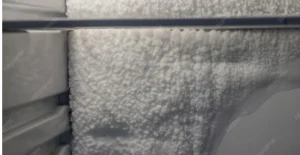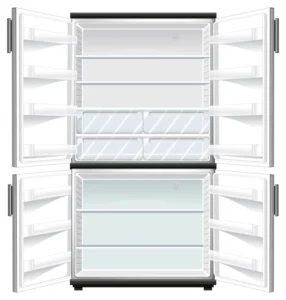Preventing Ice Formation in Your Refrigerator: Tips for a Frost Free Fridge
Hello Reader!
Welcome to the blog page of Rup Air Condition, one of the best AC fridge repair center in Kolkata.
A refrigerator is one of the most essential appliances in any household, ensuring that food stays fresh for longer. However, one of the most common issues that homeowners face is ice buildup inside their fridge. Ice formation can block vents, reduce cooling efficiency, and lead to unnecessary repairs. If you’re tired of dealing with ice accumulation, this guide will help you understand the causes and share expert tips on preventing ice formation in the fridge effectively. At Rup Air Condition, the best fridge repair center in Kolkata, we provide expert solutions for all your refrigerator-related concerns.

Understanding the Causes of Ice Formation in Your Fridge
Before diving into prevention methods, it is crucial to understand what causes ice buildup. Here are the most common reasons:
- Frequent Door Opening – Opening the refrigerator door too often or leaving it open for long periods allows warm air to enter, which condenses and freezes inside the fridge.
- Faulty Door Seals – If the rubber gasket around your refrigerator door is damaged or loose, it can cause warm air to seep inside, leading to ice formation.
- Improper Temperature Settings – Setting the temperature too low can cause excessive cooling and lead to unnecessary frost buildup.
- Blocked Air Vents – When vents inside the fridge are obstructed, cold air circulation is disrupted, leading to ice accumulation in certain areas.
- Malfunctioning Defrost System – A broken defrost heater, thermostat, or timer can lead to continuous ice formation.
Expert Tips for a Frost Free Fridge
Now that you understand the causes, let’s explore effective ways to preventing ice formation in the fridge and keep it functioning efficiently:
1. Check and Maintain Door Seals
A worn-out or loose gasket allows air leaks, causing moisture to enter and freeze. Inspect your door seal regularly and clean it with warm, soapy water to ensure a tight fit. If you notice cracks or looseness, replace the gasket immediately.
2. Set the Correct Temperature
Maintaining the right temperature inside the refrigerator is key to achieving a frost free fridge. The ideal fridge temperature is between 3°C to 5°C, while the freezer should be around -18°C. Avoid setting the temperature too low, as it can trigger ice formation.
3. Avoid Overloading Your Fridge
Overstuffing the refrigerator blocks airflow, causing cold air to become trapped and leading to ice buildup. Keep food items organized and avoid placing objects directly against the vents.
4. Limit Door Openings
Every time you open the fridge door, warm air enters and condenses, forming frost over time. Be mindful of keeping the door open for the shortest duration possible to reduce moisture buildup.
5. Regularly Defrost Your Fridge
If you own a manual defrost refrigerator, make it a habit to defrost it regularly. Turn off the fridge, remove all food items, and let the ice melt naturally. Use a soft cloth to wipe away excess moisture before switching it back on.
6. Keep Your Fridge Clean
Regular cleaning prevents ice formation and maintains your frost-free fridge. Wipe down spills immediately, clean shelves, and ensure vents remain unobstructed.
7. Check for Defrost System Issues
If ice buildup persists despite your efforts, your refrigerator’s automatic defrost system might be faulty. A broken defrost timer, heater, or sensor can cause continuous ice formation. Contact Rup Air Condition, the best fridge repair center in Kolkata, for professional inspection and repair.
8. Position Your Refrigerator Properly
Ensure that your refrigerator is positioned at least 2-3 inches away from the wall to allow proper airflow. Poor ventilation around the fridge can lead to excessive cooling inside, causing frost buildup.

What are the most common causes of ice buildup in refrigerators?
Ice buildup in refrigerators is a common issue that can be caused by several factors. Here are some of the most common causes:
1. Faulty Door Seals
- Damaged or Worn-Out Seals: If the door seal is damaged, warm air can enter the fridge or freezer, leading to condensation and subsequent ice formation. Regularly inspect the seal for cracks or gaps and replace it if necessary.
2. Incorrect Temperature Settings
- Too Low Temperatures: Setting the fridge or freezer to temperatures that are too low can cause excessive ice buildup. Ensure the fridge is between 35°F and 42°F (2°C to 6°C) and the freezer is at 0°F (-18°C).
3. Poor Ventilation
- Blocked Air Vents: Overcrowding or blockages in air vents can disrupt airflow, causing moisture to accumulate and freeze. Regularly clean vents and ensure there is enough space for air to circulate.
4. Frequent Door Openings
- Moisture Entry: Frequent or prolonged door openings allow warm, humid air to enter, leading to condensation and ice buildup. Minimize door openings and ensure they are closed securely.
5. Hot or Wet Food
- Placing Hot Food: Adding hot or wet food directly into the fridge or freezer can increase moisture levels, leading to ice formation. Allow food to cool before storing it.
6. Overfilling
- Reduced Air Circulation: Overfilling the fridge or freezer restricts air circulation, which can lead to moisture accumulation and ice buildup. Ensure there is enough space between items for air to flow.
7. Defrost System Issues
- Faulty Defrost Timers or Heaters: Problems with the defrost system can prevent regular melting of frost, leading to excessive buildup. Consult a professional if you suspect issues with these components.

How can I improve ventilation in my refrigerator to prevent ice buildup?
Improving ventilation in your refrigerator is crucial for preventing ice buildup. Here are some steps you can take to enhance ventilation and reduce the likelihood of ice formation:
1. Ensure Proper Air Circulation
- Don’t Overcrowd: Keep enough space between items in both the fridge and freezer compartments to allow cold air to circulate freely. Overcrowding can block air vents and lead to moisture accumulation, which freezes into ice.
- Organize Food: Arrange food in a way that allows air to flow around each item. This helps maintain consistent temperatures and prevents moisture from accumulating in specific areas.
2. Check and Clean Air Vents
- Regular Cleaning: Regularly inspect and clean air vents in both the fridge and freezer. Dust, debris, or ice buildup can block these vents, disrupting airflow and leading to ice formation.
- Clear Obstructions: Ensure that no food items or containers are blocking the air vents. Move items away from vents to ensure unobstructed airflow.
3. Maintain Proper Door Seals
- Inspect Door Seals: Check the door seals for any damage or wear. A faulty seal allows warm, humid air to enter, leading to condensation and ice buildup.
- Replace Damaged Seals: If the seal is damaged, replace it to ensure a tight seal when the door is closed.
4. Level the Refrigerator
- Proper Alignment: Ensure the refrigerator is level. An uneven refrigerator can cause the door to not close properly, leading to air leaks and ice buildup.
5. Monitor Humidity Levels
- Reduce Door Openings: Minimize the number of times you open the fridge or freezer doors, as each opening allows warm, humid air to enter.
- Avoid Hot Foods: Do not place hot or wet food directly into the fridge or freezer. Allow food to cool down before storing it to prevent moisture buildup.
Also Read: How To Prepare Your AC For Summer Season?

What is the ideal temperature setting for my fridge to prevent icing?
To prevent icing and maintain optimal conditions for food storage, the ideal temperature settings for your fridge are as follows:
- Refrigerator Temperature: The recommended temperature range for the main compartment of your fridge is between 1.7°C and 5°C (approximately 35°F to 41°F). This range helps prevent bacterial growth and maintains food freshness without causing excessive moisture that could lead to ice buildup.
- Freezer Temperature: For the freezer, the ideal temperature should be at or below -18°C (0°F). Some models may allow temperatures as low as -23°C (-9.4°F) for optimal freezing conditions.
Tips to Prevent Icing:
- Avoid Overcrowding: Ensure there is enough space between items for air to circulate freely, reducing moisture accumulation.
- Check Door Seals: Regularly inspect and maintain door seals to prevent warm air from entering the fridge.
- Monitor Humidity: Minimize door openings and avoid placing hot or wet food directly into the fridge to reduce moisture levels.
By maintaining these temperature settings and following these tips, you can prevent excessive ice buildup and ensure your fridge operates efficiently.

How does the CoolSaver Freezer Panel work to prevent ice buildup?
The CoolSaver Freezer Panel is designed to prevent ice buildup in freezers by utilizing natural minerals that work in two primary ways:
- Preventing Condensation: The minerals in the CoolSaver panel treat water molecules on a surface chemical level, preventing them from transitioning from humidity to condensation. This process is often referred to as molecular filtration, which does not involve absorbing moisture like traditional desiccants but rather alters the properties of water molecules to prevent ice formation.
- Reducing Humidity: By maintaining dry air, the CoolSaver panel makes it easier for the freezer to cool down, as dry air is more efficient to cool than moist air. This not only helps in reducing ice buildup but also leads to significant energy savings, up to 30% in some cases.
Key Benefits of CoolSaver Panels
- Energy Savings: By reducing moisture and preventing ice buildup, CoolSaver panels help lower electricity consumption and prolong the lifespan of freezer equipment.
- Less Defrosting: The panel reduces the need for frequent defrosting, making maintenance easier and less time-consuming.
- Improved Food Quality: By maintaining a stable temperature and reducing moisture, CoolSaver panels help keep frozen food in optimal condition, extending its shelf life.
- Easy Installation: The panels require no installation or electricity; simply place them in the freezer to start benefiting from their effects
When to Seek Professional Help
If you’ve tried all these tips but still notice excessive ice formation, it may indicate a technical issue that requires expert attention. Some signs that your refrigerator needs professional servicing include:
- Continuous ice buildup despite regular defrosting
- Faulty or ineffective temperature controls
- A damaged door seal that doesn’t stay shut
- Unusual noises coming from the fridge
At Rup Air Condition, we specialize in refrigerator maintenance and repair, ensuring that your fridge functions at its best. As the best fridge repair center in Kolkata, we offer quick and reliable solutions to all your refrigeration problems.

FAQ
- Why does ice build up in my refrigerator?
Ice buildup occurs due to frequent door openings, faulty door seals, incorrect temperature settings, or a malfunctioning defrost system.
- What is the ideal temperature setting to prevent ice formation?
Keep your fridge between 3°C to 5°C and the freezer at -18°C to maintain optimal cooling without excessive frost.
- How can I stop ice from forming in my fridge?
Regularly check door seals, avoid overloading, limit door openings, keep air vents clear, and ensure proper temperature settings.
- Why is my frost-free fridge still forming ice?
A faulty defrost system, blocked vents, or improper fridge positioning can cause ice buildup even in frost-free models.
- When should I call a professional for ice buildup issues?
If ice persists despite defrosting and maintenance, it’s best to contact Rup Air Condition, the best fridge repair center in Kolkata, for expert assistance.
Conclusion
A frost free fridge not only enhances cooling efficiency but also extends the lifespan of your appliance. By following these simple yet effective tips, you can significantly reduce ice formation and keep your refrigerator running smoothly. However, if your fridge continues to develop ice despite these measures, Rup Air Condition is here to help. Contact us today for expert fridge repair services and ensure your appliance remains in top condition!






